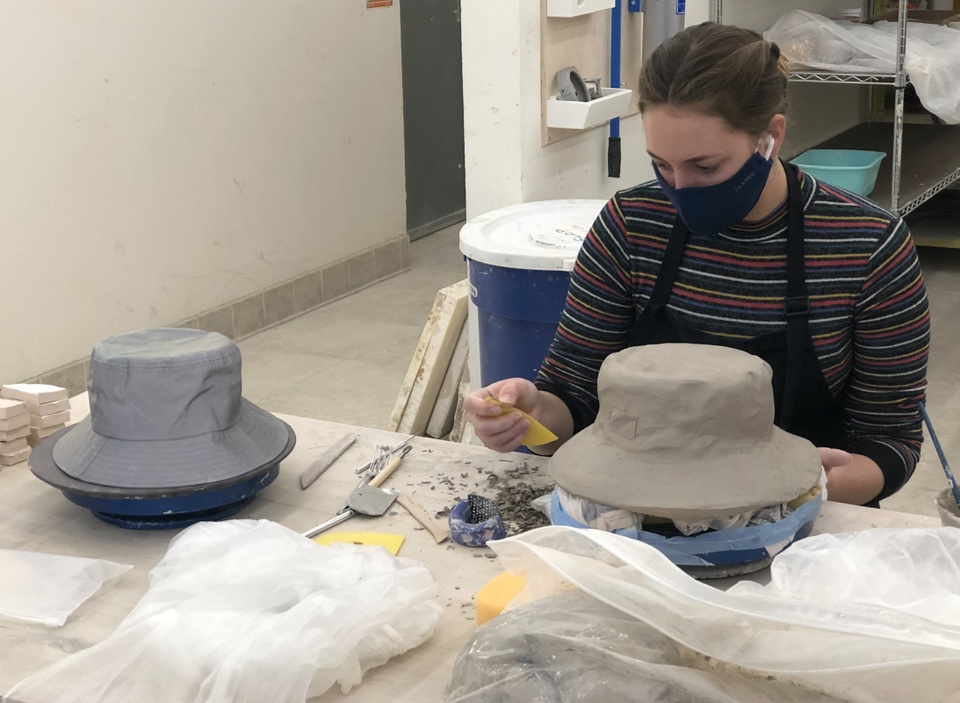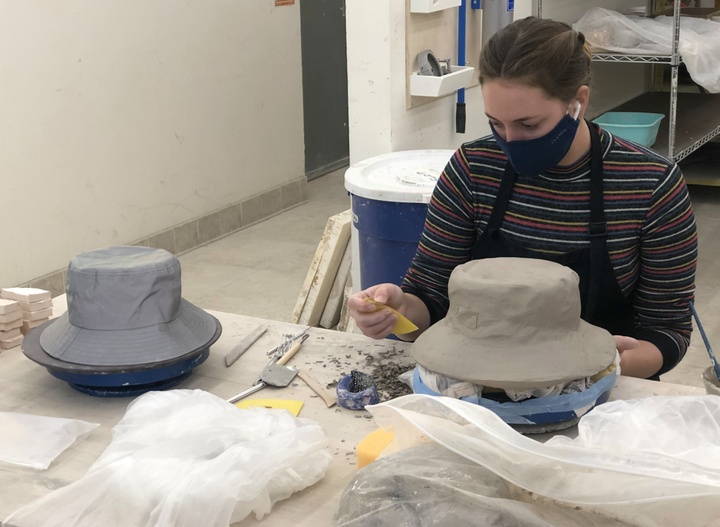Fall 2022 Art Courses
This page features a selection of studio art courses being offered in fall 2022. Offerings are subject to change; please visit WUCRSL for the latest updates and course registration.
Engaging Community: Understanding the Basics
What does it mean to engage in community as a creative practitioner? Community engagement must be grounded in authentic relationship building and an ability to understand and act within the historic context and systems that impact communities. We will practice the skills of listening, observation, reflection, and improvisation. We will cultivate mindsets that focus on community assets and self-determination. Workshops will teach facilitation and power analysis, with the intention of upending the power dynamics between community and creators. No prerequisites. May count toward the minor in Creative Practice for Social Change if bundled with “You are Here: St. Louis’ Racial History Through Sites and Stories.”
Course number: F20 ART 108B, F20 ART 208B, F20 ART 308B, F20 ART 408B
Faculty: Liz Kramer
Compositions in Clay
This course uses clay as a material to push ideas, questions, and narratives of expression into compositions. Learn basic hand-building techniques to create sculptural and functional forms. Explore alternative materials to create experimental projects, broadening your understanding of clay as a viable medium of visual expression, three-dimensional exploration, and problem solving. Demonstrations and discussion are based on hand-building techniques, wheel-throwing skills, and the use of alternative materials and methods to create forms. Discussion includes the history and traditions of ceramics along with contemporary making in clay. Exercises build practice and confidence with clay as a material in preparation for assigned projects, building a dialogue of personal story with new ways of constructing. This course emphasizes site specificity for installations and wall presentations, critical assessment, and articulation of material through reviews and critiques.
Course number: F20 ART 113Q, F20 ART 213Q, F20 ART 313Q, F20 ART 413Q
Faculty: Andrea Moon
Architecture Through the Photographic Lens
This course provides technical and conceptual frameworks for understanding architectural space as seen through the camera. Topics include building as site, landscape as context, and the architectural model as a representation tool. Students are introduced to a wide range of artists and architects, helping build a unique camera language to support their individual projects. Students will learn DSLR camera basics, fundamentals of Photoshop, digital printing techniques, and studio lighting for documenting architectural models. The course assumes no prior experience with digital imaging technologies or materials. Digital camera required.
Course number: F20 ART 117M, F20 ART 217M, F20 ART 317M
Faculty: Jennifer Colten
The Art of Medicine
This interdisciplinary, cross-school course illuminates the crucial interaction between medicine, visual culture, and the arts. The encounter between medicine and art has been cooperative, leading to numerous innovations such as the microscope, and also fiercely antagonistic, as witnessed during the HIV AIDS pandemic in the 1980s and in our current COVID era. Together with distinguished guest speakers, we will break down simplistic distinctions between the cultures of art and medicine and confront past and present representations of health and illness through the lenses of gender, race, disability, transhumanism, and diverse medical cultures. This course is designed to engage students from all schools, but will be especially fruitful for pre-health and art students. First-year (non-transfer) students only. No final.
Course number: F20 ART 130B
Faculty: Messbarger, Olynyk, Niles, Recupero, Desai
Anatomy Figure Structure
This rigorous drawing course explores traditional and new representations of the figure through the study of its structure and contemporary contexts. Research involves basic anatomy lectures and sketchbook activities, which provide a vehicle for discovering the figure’s architecture, mechanics, and proportions. Art production is based on in-class and outside projects. Lectures, presentations, critical readings, and the analysis of historical and contemporary figurative works support students in their investigations. Prerequisites: F10 101A or 102A Drawing.
Course number: F20 ART 201E, F20 ART 301E, F20 ART 401E
Faculty: Jamie Adams
Digital Fabrication for Object Making
Students will explore the potential of digital tools to develop, design, and manufacture components to create tangible sculptural forms. Students will focus on “component manufacture” as a means of sculptural production, such as creating linkages, universal fittings, and adaptors to connect disparate materials. Toys, mechanical systems, and construction products will be researched as inspiration. Students will be introduced to software such as Rhino, AutoCAD, and SolidWorks and explore each platform’s potential to design 3D forms. The class will use a variety of output tools, primarily laser cutters, 3D printers, and CNC routers, and introduce the concept of kitbashing and the modification of found and salvaged parts. This course is for artists, designers, engineers, and anyone interested in the possibilities of digital fabrication tools in the creation of sculpture. No prerequisites.
Course number: F20 ART 213J, F20 ART 313J, F20 ART 413J
Faculty: TBA
Printmaking: Contemporary Processes
This course is designed to give a broad introduction to contemporary processes and approaches in printmaking, including digital technology. Emphasis will be on image development through the manipulation and combination of techniques to create one-of-a-kind prints and variable editions. Students are encouraged to work at a level suited to their individual technical skills and conceptual interests.
Course number: F20 ART 215T, F20 ART 315T, F20 ART 415T
Faculty: Sage Dawson
Drone Photography
This combination studio and discussion-based course examines the use of small unmanned aerial systems (sUAS)–otherwise known as drones–as a photographic medium. Studio sessions will introduce students to sUAS operation, various editing platforms, and output strategies. Lecture and discussion sessions will discuss FAA regulations, explore ethical implications of sUAS use by visual artists, and examine the rise of sUAS in visual arts within the context of the history of aerial photography. Students will produce a body of work using drone capture as the primary medium. To ensure equal access to sUAS, students will be required to meet outside of class sessions (for flying time) intermittently throughout the semester–once a week from mid-September to late October. Students must register for either Subsection A or B.
Course number: F20 ART 217P, F20 ART 317P, F20 ART 417P
Faculty: Meghan Kirkwood
Structural Ceramics
This course advances study in 3D practices in clay processes and sculpture. Students will explore several techniques in clay with an emphasis on hand building. Methods of creating include coiling, slab building, casting, and subtractive modeling. Surface design with cold finishes and glazes, firing processes, and mold making will be explored as a means of building and finishing content. Students will practice and research clay as a material that engages in structure and introduces new sculptural ideas defining scale, balance, form, etc. Discussions and presentations will focus on the history and contemporary traditions of ceramic structures and sculptures, with emphasis on critical assessment and articulation of material.
Course number: F20 ART 319J, F20 ART 419J
Faculty: Andrea Moon
Furniture Design
This course explores design and fabrication methods for objects of human interaction. Each student will design and build a table based on a unique concept. It is up to the individual student to define what their table is for and clearly communicate their intentions and ideas. Design and production will combine contemporary technologies with traditional techniques of metal fabrication, woodworking, and plastic forming. Students will learn how to work directly with machinery and materials in the realization of their designs. This course will introduce advanced techniques, and students will select those most appropriate to their work to build upon. A high level of craft and independent investigation are required to excel in this course, and students are expected to have basic shop skills addressed in course prerequisites. College of Architecture and College of Art sophomores, juniors, and seniors have priority. Fulfills Sam Fox Commons requirement.
Course number: F20 ART 347X
Faculty: Lindsey Stouffer
FOOD: Performative and Immersive (New!)
This studio/seminar course explores food and eating as elements to be considered historically and through the five senses. From the dawn of civilization, cultural customs have evolved around food, its production, and its consumption. Rituals were created to gather people around food and eating. We unpack personal and communal food experiences, consider the environments of those meals, and discover elements of past and present. By creating immersive experiences, we deconstruct the mechanism of eating, exposing patterns and norms involved. The course culminates in a communal event in which students present their work as immersive installations. No prerequisites, junior or higher standing.
Course number: F20 ART 351B, F20 ART 451B
Faculty: Carmel Bar and Michal Evyatar
Lost in Space: Media Art and Immersive Environments
The participatory turn in art over the past five-and-a-half decades has produced an array of immersive environments that enhance the viewer’s perception of their body and heighten awareness of their bodily relationship to space. Technology often activates many spatially-oriented works, dramatically altering the tenor of the embodied experience while offering new ways to shape our sense of presence within the physical world. This primarily seminar-based course will explore installation art and immersive environments, many of which use evolving technologies or time-based media to affect the viewer’s awareness of their bodily existence. Examples will include Olafur Eliasson’s Fog Room and Multiple Shadow Room, James Turrell’s Light Reignfall, Yayoi Kusama’s Infinity Mirror Rooms, Anish Kapoor’s Cloud Gate and Whirlpool, Jennifer Steinkamp’s Jimmy Carter, Krzysztof Wodiczko’s A House Divided, Cyprien Gaillard’s Nightlife, and Won Ju Lim’s California Dreamin’. This course will also explore how immersive spaces operate on different registers while reinforcing the viewer’s recognition of themselves as doppelganger, as hybrid, or as Other. Students will learn how each work tinkers with the viewer’s perception of their own bodily scale and encourages spectacular forms of engagement that reinforce corporeality.
Course number: F20 ART 397A
Faculty: Patricia Olynyk









